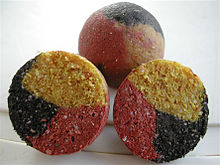Boilie

Boilies are boiled paste fishing baits, usually combinations of fishmeals, milk proteins, bird foods, semolina and soya flour, which are mixed with eggs as a binding agent and then boiled to form hardish round baits which will last in the water. Additional flavourings and attractors are also usually included in the mix. The round shape allows the baits to be catapulted accurately when fishing at range.[1]
First formulated in the 1970s, the boilie was the invention of Lenny Middleton and Kevin Maddocks, who were, as many anglers were at that time, looking for a way to avoid the attention of other fish species which were all too commonly a distraction when targeting carp. The ability to provide a bait of a fairly large size with a hard outer skin, meant that the other species such as tench and bream were less able to consume the bait. Boiled baits also meant that they could be left longer in the water without fear that they had fallen off the hook, in the same way as bread or other traditional baits might.[2]
Boilies are now one of the most established carp baits, available in a huge range of colours and flavours. Boilies come in all different shapes and sizes, from tiny micro boilies (some even as small as eight millimetres) up to as large as 40 mm which are more suited to waters where 'nuisance fish' are present.
There are buoyant boilies, commonly known as pop-ups, that are used to make the bait sit just off the bed of the lake making them easier for the fish to find and take. Pop-ups can be used in various situations, where there is weed or silt present on a lake bed, or with a normal boilie to create a 'snowman' rig, the pop-up is generally smaller than the normal boilie, this creates what is known as a critically balanced bait, or neutral buoyancy, and makes it easier for the fish to take in the bait.[3]
The carp angler has an enormity of types of boiled bait to choose from, some of which have added preservatives in them so that they can be kept at room temperature on shop shelves for a long time (shelf-life bait). Boilies that lack these added preservatives need to be refrigerated or frozen to stop them from going off; these are known as freezer baits. There have been many arguments discussing the pros and cons of both freezer and shelf-life boilies but the common opinion of many carp anglers is that due to the artificial preservatives in shelf-life baits they are not as nutritionally beneficial to the carp and therefore lack some attraction. Also, since in order to keep freezer baits fresh they need to be frozen soon after being rolled, not only will the ingredients used be of a much higher quality than in shelf lives but the ingredients used to make them will not lose much of their nutrients and attraction before being used in a fishing situation (much like frozen vegetables). Due to these facts freezer baits are often much more expensive than their shelf life counterparts.
The most commonly used set-up anglers use to present a boilie is a hair rig (knotless knot) which allows the boilie to sit off the back of the hook. This not only means that the bait will behave more naturally in the water (for example when disturbed by feeding fish) it also will often make the difference between a good hook hold and a bad one. Due to the nature in which a carp feeds the bait is blown out of the mouth soon after it has been picked up and the fact that the bait can move independently from the hook it allows the hook to stay back inside the mouth and find its way preferably into the bottom lip.
References
- ^ Lesley Crawford (2005). The Fishing Companion: Amazing Angling, Curious Catches & Pescetarian Passions. Robson. ISBN 1861059191.
- ^ Carp fishing Science, Jon Wood, 2008
- ^ Pop-up baits
External links
- Professional bait making (video)
- Boilies | Boilie Making | Boilie Receipes
- Sweet Boilie Recipes | Savory Boile Recipes


